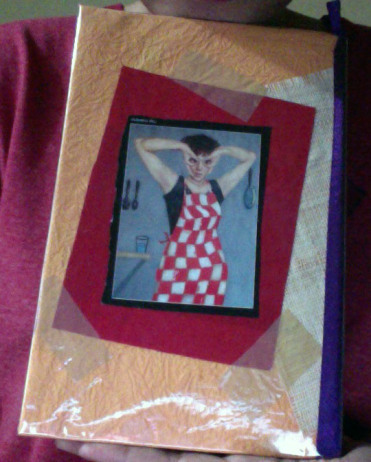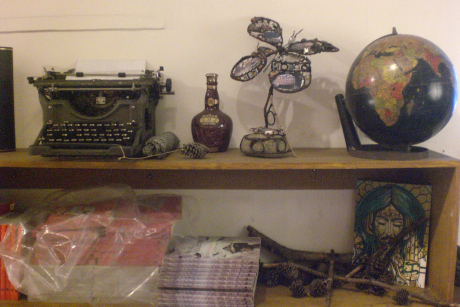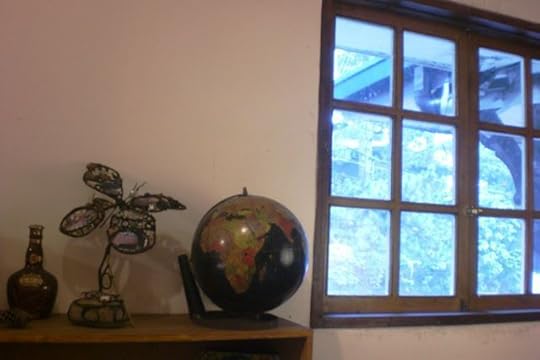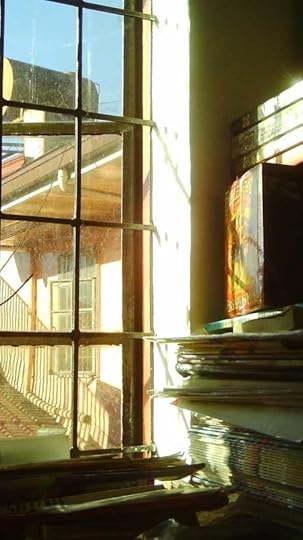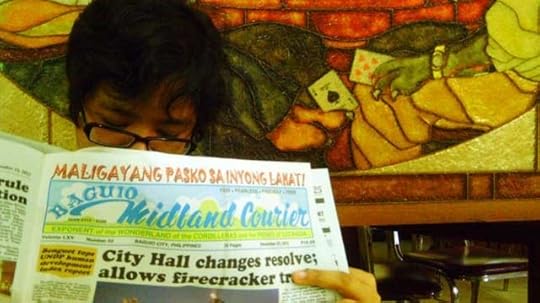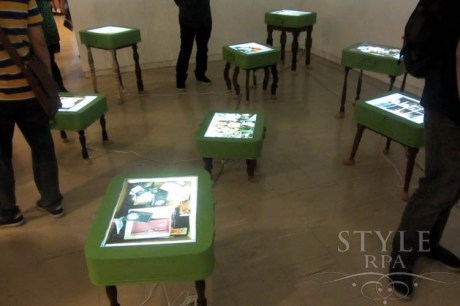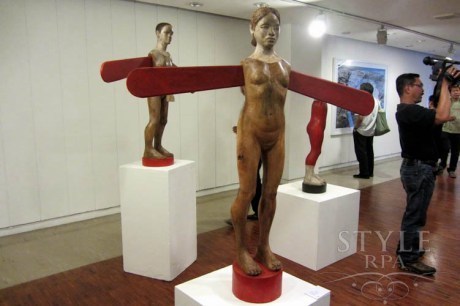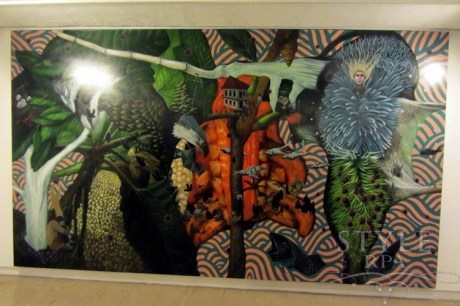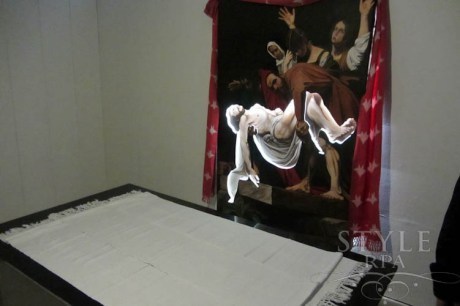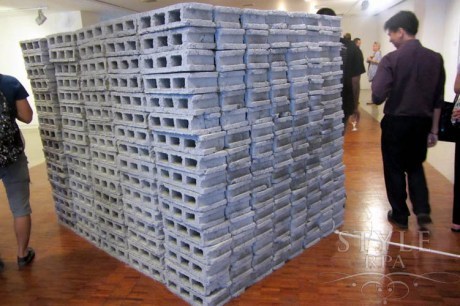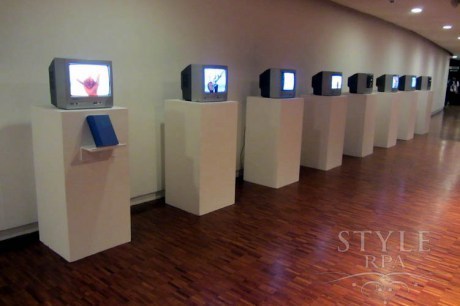Faye Cura's Blog, page 13
January 25, 2013
New Office
January 3, 2013
Handmade Notebooks
In making notebooks like these you can recycle 50 or so sheets of coupon bond. Fold each sheet vertically in the middle to hide the writings on one side. Collate & straighten the leaves, making sure that there are no loose pages. Put a generous amount of Elmer’s Glue on the side where the two edges of the pages meet. Then bind all the leaves with a thin piece of cardboard–any appropriately sized cheap box will do. Afterwards, cover the cardboard with your own artwork.
To cover the notebook below, I used a plain, gold-colored piece of paper that once wrapped a box containing a white pashmina which I got as a Christmas gift. I call this notebook, “The Golden Notebook.”
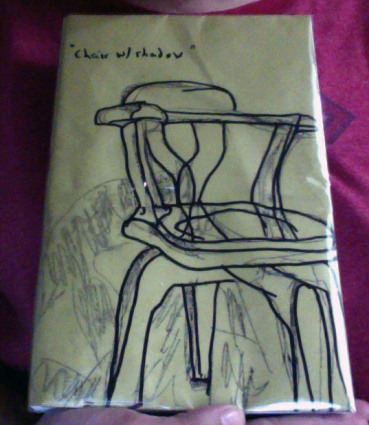
“Chair w/ shadow”
For the design, I tried to make a contour drawing on the smooth paper. But I couldn’t think of anything to draw. I haven’t drawn in years. So I settled with drawing this chair with black Magic Ink, after producing the watery effect that resulted from the resistance of Stabilo Pen 68 ink to the paper.
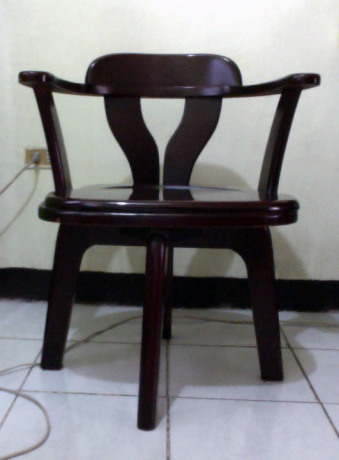
One of the chairs we found along Evangelista Street
To cover the notebook below, I used as the base a crumpled piece of orange paper that once wrapped Brenda Shaughnessy’s Interior with Sudden Joy, which I got for my birthday. I pasted the piece of banig-like material that was tied around my bestfriend’s wedding souvenir–a bottle of blueberry jam–on the spine. I also bordered the notebook with the violet ribbon that came with the orange wrapper. Then I found a nice image by Luis Cornejo in an old issue of ArtNews magazine & pasted this on another cutout to complete the composition.
I meant for this to be a gift, but in this age of laptops I couldn’t think of anyone who would really appreciate receiving a recycled notebook. I was also starting to take home cooking seriously during the time that I was making it. & Cornejo’s image shows a girl who seems to be having fun in what seems to be a kitchen. So I decided to turn the notebook into a recipe book. Here are some recipes inside:
That’s Tahong Carambola, Cabbage & Black Beans, Sprouted Mung Bean Curry, & Dory in Balsamic Vinegar. Domestic bliss, it is!


December 28, 2012
Books in Baguio
There are a number of bookstores in Baguio City aside from those at SM.
It’s a shame that Booksale left its stall in Maharlika Livelihood Center & transferred to SM. When I was in college, I bought my paperbacks from that Booksale, as well as from Diplomat in Center Mall. Among those paperbacks which I love until now are Joan Didion’s The White Album, JD Salinger’s Franny & Zooey, and Simone de Beauvoir’s All Said & Done.
There is now, of course, Mt Cloud Bookshop in Casa Vallejo, which sells foreign & local titles on art, travel, fiction, nonfiction, poetry. Its comic book collection, which unfortunately is for in-house reading only, is simply fantastic: there are old issues featuring the works of Robert Crumb, for example, as well as newish books by Chris Ware, Dash Shaw, Lynda Barry, & others. The interior design is also — uh, heavenly.
At Mt Cloud this holiday season, we bought Image & Meaning by Alice Guillermo, Consuming Passions: Philippine Collectibles, edited by Jaime Laya, a couple of cute notebooks, & this:
A&P Thrift Shop, meanwhile, specializes in college textbooks, but across it is a narrow stockroom full of fiction & nonfiction books. This thrift shop also dates back to my college years, perhaps even earlier. I used to sell some of my old books (e.g. Sophie’s Choice, A Portrait of the Artist as a Young Man) here.
Here we found Method & Madness, a biography of Sylvia Plath. In the stockroom, we climbed over boxes & found this:
It’s a novel set mostly in Baguio written by a member of WOMEN (Women in Media Now), a group of journalists in the 1980s. We also found Guillaume Apollinaire’s book of calligrams, in French, & this:
Every weekend in front of the building, the old couple who owns A&P displays a few hundred paperbacks placed on a couple of shelves & on a makeshift table. I think that they’re attempting to sell other objects besides books in their store upstairs–we found boxes of used shoes & bags, as well as several coffeemakers, along the narrow spaces between & above shelves. As in anywhere in the city, there’s just no space!
Meanwhile, on the first floor of La Azotea Building, which also houses Oh My Gulay! Vegetarian Restaurant, is Flash MJ Bookstore.
It offers the usual paperbacks, but then we found Malcolm Lowry’s Lunar Caustic here, & these:
There are other bookstores around town, such as Diplomat, CID Bookstore, Jet Bookstore, even Rex Bookstore (which also owns a whole dormitory for college students) & C&E Publishing. There is also, of course, the spacious public library in Burnham Park.
I’d like to think of Baguio City as a “reading community.” My Uncle Rey, for example, a long-time resident of Baguio, had a large collection of paperbacks which was turned over to my mother when he died. The collection included Rex Stout’s Nero Wolfe series, which I just ignorantly ignored until they were given away. Now I find Nero Wolfe books quite hard to find. I found A Right to Die at home, however, & it served as my reading fare during the holidays.
My Auntie Eden, also a Baguio local, has also served as my mother’s source of books through the years. I remember my mother reading one of these books, John Fowles’ The Magus, for just over a day one time I was home. I got my love for reading from my mother, who has lived all her life in Baguio City.
Baguio is a reading community. It publishes yearbooks quite regularly (available in the local bookstores are the 2005 & 2008 issues), & the small circle of writers put together coffee-table books on Baguio (& the Cordilleras, actually), academic books, & publications like The Baguio We Know & Ukay-Ukay: What to Do in Baguio When You’ve Seen the Sights.
It isn’t only books that are being read in Baguio (duh). There’s the longest-running weekly newspaper in my world, sold for P16 at every newspaper stall & at Luisa’s Cafe, where the writers & old-timers hang out.
& then there’s the “Boycott SM: Rediscover Baguio” sticker on the wall of the comfort room at La Azotea.


December 14, 2012
Kolonyal na Sining sa Pilipinas
Mga sipi mula sa panayam na “Philippine Colonial Art (1565-1898)” ni Rene Javellana, SJ, Oktubre 13, 2012, Ateneo de Manila University; mga larawan mula sa pagbisita ng awtor sa Pambansang Museo
1.
- Gayong hindi katutubo sa Pilipinas ang mga elepante, lagi nang itinuturing na pangunahing pinagmumulan ng mahuhusay na likhang garing ang bansa.
- Aprika & Asya ang pinagkukunan ng garing. Mas mahaba at kurbado ang garing na Aprikano. Mas pino naman ang mga butil ng garing na Asyano. Gawa sa garing na Aprikano ang karamihan sa mga likha sa huling mga lumipas na dantaon.
- Parang puno kung tumubo ang sungay ng elepante, kaya kung puputulin ito, makikita sa loob ang mga bilog na konsentriko mula kung saan mahihinuha kung gaano na katanda ang hayop.
- Sinusunod ng mga lilok ang hubog ng garing, kaya kung papansinin, tila nakakurba sa baywang ang ilang mga lilok ng nakatayong santo.
- Naninilaw ang garing sa natural na prosesong tinatawag na patina. Napakahirap linisin ang garing.
- Mahahalagang luklukan ng mga likhang garing mula sa Pilipinas ang museo sa Tepotzotlan, Mehiko; ang Collecion Real sa Madrid, Espanya; ang Museo Oriental sa Valladolid, Espanya; & ang Museo Franz Mayer sa Siyudad ng Mehiko sa Mehiko.
2.
- Karaniwang relihiyoso ang mga likhang garing mula sa Pilipinas. Sa panahong kolonyal, mga luho ito na ipinadadala sa Mehiko bilang regalo. Dinadala ito ng mga mangangalakal na Tsino, Biyetnames, & Arabo.
- Pagdating ng ika-16 dantaon, linililok na ang garing sa Parián, angdistritong Tsino sa Maynila.
- Itinayo sa Parián ang palengkeng Tsino sa Maynila. Una itong itinayo sa labas ng Intramuros. Pagkatapos ng pag-aalsa ng mga Tsino noong ika-17 dantaon, lumipat ang palengke malapit sa kasalukuyang pook ng Metropolitan Theater & tulay sa Quiapo. Pagkuwa, lumipat ito sa kasalukuyang kinaroroonan ng Liwasang Bonifacio & Central Post Office. Paglaon, lumipat ito sa alcaicería sa Quiapo.
- Mga lalaking Tsino ang unang manlililok ng garing—pawang mga lalaki ang unang mga dayong Tsino sa Pilipinas. Unang tinawag na Tsino-Hispano ang mga manlililok, & pagkuwa’y Filipino-Hispano (yaong mga anak ng Tsino & Filipina). Pagdating ng ika-19 dantaon, hindi na mahalaga ang etnisidad ng mga manlililok, gayong karamihan sa kanila ay kinilala na Mestizo-Tsino o Mestizo-Sangley.
- Kabilang sa mga manlililok ng ika-19 dantaon sina Isabelo Tampinco & ang anak niyang si Vidal (na ang mga likha ay makikita sa Pambansang Museo); & si Graciano Nepomuceno (na ang likha ay makikita sa Casa Manila).

“Farm Girl with a Basket” by Isabelo Tampinco, plaster cast, undated
- Naging higit na Europeo ang istilo ng mga likha noong ika-19 dantaon. Kapag sinipat ang sining kolonyal sa Pilipinas, tila ba higit na naging kanluranin ang ating kultura nang nakamit natin ang pulitikal na kalayaan. Maaari lamang ba ang kalayaang pulitikal kung ipagpapalit dito ang pagpapakandiling kultural?
3.
- Taglay ng mga unang likhang relihiyoso ang sumusunod na katangian:
> Di maikakailang silanganin ang bukás ng kanilang mukha, katulad sa singkit na mga mata & matataas na buto ng pisngi.

“Santa Ana” by unknown artist, wood, undated. Is she Chinese-looking, or what?
> Katulad ni Buddha, may mga bilbil ang mga likha. Sa Tsina, hudyat ng kasaganaan ang mga bilbil.
> May bungkos ng buhok na katulad ng pusód ni Buddha ang mga lalaking santo. Maaaring ituring na alab ng kaliwanagan (flame of enlightenment) ang bungkos na ito.
> Hindi isinunod sa klasikong mga sukat ang pangangatawan ng mga likha. Karaniwan na ang mas malalaking ulo kaysa katawan. Maaari umano itong ipaliwanag na dulot ng panghihimasok ng katutubong aestetika: sa Asya, may mataas tayong pagpapahalaga sa ulo, sa Mukha.
> Taglay din ng mga roba ang suksok, na karaniwan sa mga likha ng Birheng Maria.
- Kamukha ng Niño Dormiendo (Natutulog na Hesus) ang Nakahigang Buddha & ang katulong ng manggagamot na Tsino, isang nakahigang anyo na ang mga bahagi ng katawan ay tinuturo ng mga doktor upang matiyak ang karamdaman ng mga pasyenteng babae.
4.
- Isa sa pinakaunang likhang garing ang imahen ng Sto Rosario (1593). Linilok ito ng isang Tsino sa Maynila para sa simbahan ng Sto Domingo.
- Katulad ng maraming likha, hindi gawa sa garing ang kabuuan ng estatwa. Tinatawag na bastedor ang prosesong ganito. Gawa sa kahoy, & kinukubli ng magarbong kasuotan, ang ibang mga bahagi tulad ng katawan, hita, & braso. Ganito ang pagkakagawa sa maraming patrong Katoliko.
- Karaniwang molave, santol, o mangga ang kahoy na ginagamit sa pag-ukit sa mga santo & patron. Hindi ginagamit ang narra bunsod ng taglay nitong langis. Pinakamahusay gamitin ang narra sa paggawa ng mga muwebles.
- Noon pa man, nagmumula na sa Tsina ang mga pinturang ginagamit sa mga likhang sining sa Pilipinas. Ginagamit din sa pagpinta sa mga istatwa ang water color & ang tempera (puti ng itlog) na pinapatungan ng lacquer pagkuwa.
- Pinipintahan ang mga mukha & kamay sa prosesong tinatawag na encarnacion, na ginagamit din sa pagpipinta ng mga larawan (portraits). Minsan, umaabot sa 30 patong ang pintura.
- Katulad ng Birhen ng Antipolo, hindi kailanman iniwan ng “totoong” Sto Rosario ang simbahan. Sa mga prusisyon, mga kopya o vicaria ang ipinaparada.
5.
- Higit na tumimo ang kolonisasyong Espanyol sa mga “pagano” kaysa mga Muslim bunsod ng mga sumusunod na salik:
> Hindi buo & isa ang strukturang pulitikal ng mga pagano.
> Hindi sumasalungat sa Kristiyanismo ang mga paniniwalang animista. Halimbawa, madaling iangkop sa kulto ng mga santo ang politeismo, samantalang mahigpit na sinusunod ng Islam ang monoteismo.
> May malakas na pagkakahalintulad sa bokabularyong agrikultural ang impluwensiyang Kristiyano sa sining kolonyal ng Pilipinas. Halimbawa, maaaring katawanin ng Buto, na itinatanim ni Hesus, ang Kaharian ng Diyos.
- Maaaring ituring na “pagbibinyag sa paganismo” ang proseso ng Kristiyanisasyon.
6.
- Pagdating ng 1588, marami nang Tsinong Kristiyano sa Maynila. Noong 1602, linimbag ng isang Tsinong Kristiyano, si Juan Vera, ang Excelencias del Santisimo Rosario. Maraming Tsinong Kristiyano ang mangangalakal ng seramiko. Marami rin sa kanila ay bihasang manggagawa o karpintero, & sinasabing isinasagawa nila ang mga simulain ng firmitas, utilitas, & venustas sa mga likhang arkitektural. Maaaring ipanukala na nagsilbing daan patungo sa bago nilang pananampalataya ang kanilang hanapbuhay.
- Bunsod ng malaking plano ng mga Dominikano na gawing Katoliko ang mga Tsino, nagtayo sila ng monasteryo sa Isla ng Fuga. Gayunman, inabandona rin ang monasteryo matapos tamaan ng kolera ang isla.
7.
May kalakalan ding naganap sa pagitan ng Maynila & Macao. Isang lumang piyesa mula sa Macao ang puwesto para sa koro sa Simbahan ng San Agustin.
8.
- Dinala ng mga caravel, nao o galyon, mga nakasulat na ulat mula & tungong Europa, & ng mga prayle & misyonero ang mga kaisipan & larawang Kristiyano sa Pilipinas.
- Dumating sa bansa ang palimbagang tipograpiko noong ika-17 dantaon, & ginamit ito sa pag-ukit ng metal na sila namang pinagbatayan ng mga dibuho at ukit.
- Nagsilbi ring patron ng sining ang mga prayle. Nagtayo ng silid para sa pagpipinta ang mga Agustino sa kanilang mga monasteryo. Si Antonio Sideño ay Heswitang nakipaglaban para sa edukasyon sa sining, nagturo sa mga masong Tsino, & nagtayo ng studio para sa pagpipinta.
- Pangunahing ginamit para sa ebanghelisasyon ang sining kolonyal, na karaniwang relihiyoso. Noong ika-19 dantaon na lamang pumasok sa sining ang mga temang sekular.
9.
- Bago ang ika-19 dantaon, higit na Byzantine ang mga likhang sining. Ibig sabihin, sa mga inaprubang prototipo kumopya ang mga artisano. Kung kaya, ipinakikita ng mga ukit (engraving) ang istatwa ng Birhen, & hindi ang Birhen mismo.
- Nagsilbi ring prototipo ng mga istatwa ang mga ukit.
- Karaniwang nakabatay sa sining na Mehikano ang mga prototipo para sa mga kolonyal na likhang sining. Ipinanukala na ni Fernando Zobel na ganito rin ang nangyari sa Pilipinas sa kanyang aklat na Philippine Religious Imagery (1964).
- Mga tanda ng impluwensiyang Mehikano sa kolonyal na sining sa Pilipinas ang ginto & pulang kulay sa mga anghel & ang luntian, kahel, ginto, & pulang kulay na sinasabing orihinal na mga kulay ng Simbahan ng San Agustin.
10.
- Bilang kolonyal na istratehiya, binuo ng Opispo ng Maynila na si Domingo de Salazar, OP, ang Synod of Manila noong 1582 hanggang 1583. Tinangka nitong sagutin ang mga usaping katulad ng karapatan ng Espanya na mangolonisa; ang usapin ng katarungan, lalo na yaong karapatan & tungkulin ng mga encomendero & ang usapin ng pang-aalipin; pang-aabuso sa karapatang pantao sa proseso ng pagpapatahimik sa taumbayan; & ang tamang mga paraan ng ebanghelisasyon.
- Upang tagumpay na maakit sa Kristiyanimo ang mga Pilipino, ipinasya ng Synod na kailangan ng Espanya na:
> Gamitin ang katutubong wika, & kung gayon ay tipunin ang kaalaman sa balarila sa mga librong tinatawag na arte & ang kaalaman sa mga salita sa mga librong tinatawag na vocabulario. Kailangan ding gamitin ang palimbagan bilang suhay sa pagtuturo & pangangaral. Halimbawang produkto nito ang Arte y reglas de la lengua tagala ni Francisco Blanco de San Jose, na unang linimbag sa Bataan ni Tomas Pinpin noong 1610.
> Umangkop sa kaayusang panlipunan ng mga katutubo sa pamamagitan ng paghirang sa katutubong elit sa mga tungkulin ng kapangyarihan & ng pagtuturo sa kabataan. Mapapansin na sa mga panahong iyon, nakakamukha ng mga paupahang paaralan ang mga seminaryo pagdating sa struktura & kurikulum.
> Tumungo sa tao, gamit ang imahinasyon & damdamin o emosyon kaysa lohika, & gamit ang mga pandama kaysa diskurso sa pangangaral.
- Sa pangkalahatan, ginamit ang sining sa pagtuturo sa pananampalataya.
11.
- Isa pang istratehiyang kolonyal ang pagsasaayos sa espasyo. Makikita ito sa proseso ng reduccíon, kung saan tinipon sa mga bayan ang nakakalat na populasyon.
- Inayos ang mga bayan sa padron ng grid kung saan nasa gitna ang simbahan. Malawakang isinakatuparan sa mga kolonyang Espanyol ang ganitong kaayusan, na kinopya rin lamang mula sa kaayusan ng Klasikang Roma.
- Sa kaayusang grid, nasa cardo (hal., ang Calle Real sa Intramuros) ang pangunahing mga gusali tulad ng simbahan at ang mga gusali ng pamahalaan. Sa Intramuros, nasa gilid ng Plaza Mayor ang Calle Real.
- Nasa decumano (hal., ang Parián sa Intramuros) naman ang kalsadang pangkalakal & ang palengke.
- Sa karaniwang plaza, kahilera ng cardo & decumano ang lahat ng iba pang kalsada. Sa Intramuros, may kanal sa labas ng mga pader na naghihiwalay sa siyudad mula sa mga pamayanan sa labas katulad ng kilala ngayon bilang Luneta.
- Nasa Museo Franz Mayer ngayon ang tanyag na dibuho ng Intramuros mula sa ika-17 dantaon na natagpuan sa isang baul.
12.
- Pagsasama-sama ng lahat ng anyo ng sining ang sining kolonyal. Itinuturing itong baroque, na naglalarawan sa mapalamuting sining na lumitaw pagkatapos ng Renasimyento. Ang lahat ay isang malaking anyo ng sining.
- Nagsilbing lugar para sa lahat ng sining ang plaza. Nagsilbi ang patsada ng simbahan na likuran ng mga pampublikong pagdiriwang tulad ng fiesta, kung saan nagsama-sama ang sining biswal & ang mga sining na itinatanghal. Binubuo ng pinta, iskultura, limbag, & arkitektura ang sining biswal. Binubuo naman ng mga konsiyerto, teatro, & palabas ang mga sining na itinatanghal. Sa paglaon, napatunayang nababagay sa mga pagtitipon ng pamayanan ang plaza.
- Tinatanghal sa plaza ang mga dramang relihiyoso & didaktiko; drama tungkol sa buhay ng mga santo; & moro-moro tungkol sa mga Moro sa Europa.
- Kinakatangian ng aestetikang baroque ang fiesta, na taunang pagkakataon para pagtibayin ang ugnayan ng pamayanan.
- Pawang mga balát o pinagbalatan na lamang ang nakikita natin sa sining kolonyal sa kasalukuyan.
13.
- Isang tema o trope sa sining kolonyal yaong patungkol sa Imaheng Natagpuan (Found Image). Nakatuon ito sa kung paano natagpuan ang isang likhang relihiyoso (lumulutang o inanod sa tubig, karaniwan), o sa kung paano ito nawala & natagpuang muli.
- Isang kuwento ang tungkol sa Sto Niño na umano’y natagpuan sa Cebu noong 1565 ng mga sundalong Espanyol sa pangunguna ni Juan Camus. Pinaniniwalaang ito ang mismong imahen na binigay ni Magellan kay Raha Humabon.
- Iba pang mga Imaheng Natagpuan yaong kina Nuestra Señora de Guia ng Ermita (c 1571); Birhen ng Casaysay ng Taal (c 1639); Nuestra Señora de la Soledad de Porta Baga ng Cavite (c 1692; kasama ang isang pinta mula 1684); Inmaculada Concepcion de la Paz Buenviaje ng Antipolo, na binigay ni Gob. Niño de Tabora; & ang Señor Nazareno mula sa Mehiko, na linipat mula sa Simbahan ng Recolletos patungong Quiapo (c 1609). Tatlo o apat ang pares ng paa ng Nazareno, sapagkat napudpod na ng walang-patid na paghagod ng mga deboto ng ilang daang taon ang orihinal niyang mga paa.
14.
Nang lumawak ang industriya ng paglilimbag, nausong batis ng mga disenyo ang mga viñeta, yaong mapalamuting disenyo sa gilid ng pahina ng libro na madalas makita sa simula & wakas ng isang kabanata. Makikita ang ganitong disenyo sa inukit na mga pinto sa simbahan ng Asuncion de Nuestra Señora sa Maragondon, Cavite.
15.
- Isang halimbawa ng kolonyal na retablo at alsadong bas ang Heswitang altar sa simbahan ng Nuestra Señora de Candelaria sa Silang, Cavite.
- Sa itaas ng altar naroon ang mga istatwa ng mga martir na Hapones, na ang buhay ay ipinagdiwang sa Maynila. Sila sina Paul Miki, John Goto, & iba pang martir ng Nagasaki na namatay para sa kanilang paniniwala.
- Ginawa noong circa 1663 ang mga ukit mula sa kahoy na pinatungan ng Plaster of Paris & pandikit. Pinasakan ng papel na Tsino ang mga butas.
- Iba pang detalye ng altar ang mga kerubim (putti sa Italyano) & ang araw na baroque, isang motif na iniuugnay sa mga diyos na Perubyano.
- Ang altar na ito ay huwaran ng maayos na pagsasama ng mga disenyong alsado at ng istatuwaryo. Pagdating ng ika-19 dantaon, mga istatwa na lamang ang linilikha. Ipinapalagay na bunga ito ng paglawak ng kakayahan ng taumbayan na bumasa & sumulat, kung kaya hindi na nila kinailangan ng mga suhay na biswal, tulad ng altar, upang maunawaan ang kanilang pananampalataya.
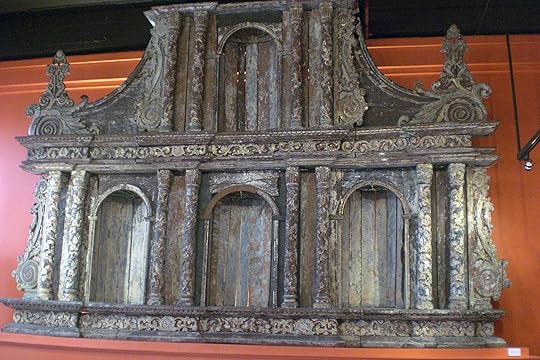
“Retablo,” unknown artist, Philippine hardwood, c 18th century


November 19, 2012
Field Note
See you this Saturday in Winner Jumalon & Pachingguel Hortillanos’ Recent Find at the Manila Contemporary!


November 17, 2012
Thirteen ‘Twelve
Unfortunately we obediently deposited our camera with the guards at the entrance of the CCP so we weren’t able to take any photos of the works. I think that CCP should allow cameras inside, especially in exhibits of contemporary works, which we all know are difficult to document. All photos here courtesy of Style RPA.
I appreciate how the curator of the 2012 Thirteen Artists exhibit tried to make the show, as well as the works of the individual artists, as accessible to the public as possible. This is achieved by including wall notes that sometimes explain not only the exhibited works, but also each awardee’s background & artistic preoccupations. Exhibited as well are the artists’ studies & proposals, shedding light on their working process. By the entrance to the gallery is a TV monitor where the audience can view a documentary of the artists briefly answering the question: “Why do you make art?” I love how the show makes every effort to reach out to the audience &, with all the flak that CCP has been receiving since last year’s Kulo hullaballoo, seemingly try to justify the existence of the Thirteen Artists institution itself.
I like Walking Suitcases by Marina Cruz because of its simplicity & cohesion. Various objects are collected into photographed sets contained in resin suitcases, helping the viewer figure out a narrative, or write her own, by compartmentalizing the memories that are put in place. The found balustrades that serve as the suitcases’ feet also call to mind old houses, strengthening the idea of family histories. The wooden literal feet that design the balustrades & the green color of the suitcases suggest movement & life to an otherwise static installation.
I also like Riel Hilario’s woodworks. The title, What is essential is invisible, is a reference to the classic children’s story that complements the artist’s recollection of wanting to fly as a child. The title also gives the work a religious sense that is first made felt by the fact that the wood used is the same as that from which santos are carved.
Rodel Tapaya’s painting is like a contemporary epic, or a long-winding riddle. It’s composed of fantastic images like giant birds, Miyazaki-like flying ghosts, suspended diorama-sized houses, &c. These images of different proportions meld with each other, & following each of their movements with the eye is an engaging exercise. The blank space on the adjacent wall makes me wonder, though, if there are supposed to be two paintings, as indicated in the artist’s studies. It would have been an interesting diptych. The narrative or narratives from the universe that Tapaya created could easily extend onto another painting (& a third & a fourth).
I feel that Michael Muñoz’s work is heavy with references, making it difficult to appreciate. Entering the alcove in which the work is installed is like entering a sacrificial room. Kandila & Gregorian chant na lang ang kulang. I feel that there is a continuity of meaning—from the graffiti work of a hooded man on one wall to the indigenous white cloth on the table at the center to the Western, classical religious painting on the parallel wall—that is somehow disrupted, if not lost (or lost on me, at least).
Mark Salvatus’ installation is a pretty straightforward commentary on the frustrations of urban habitation. The block of hollow blocks is as claustrophobic as the looped audio recording on the amenities of urban residences for sale or for rent that issues from it.
The show is teeming with sound, by the way. Kiri Dalena’s work is pure sound—a recording of a storm’s howling wind, playing in the building’s elevator. Would it have been more powerful if the howl—or the roar, depending on how you hear it—could be heard in the whole building? Joey Cobcobo’s printwork of, if I remember right, Jesus Christ on handmade paper is accompanied by a recording of one of our “modern prophets,” those you see standing on the sidewalk or getting on the bus, preaching about how our wayward ways bring us closer to the end of the world. There’s Salvatus’ recording, & also the sounds of the various video clips on war, I think, along with a grand underscore, that make up Renan Ortiz’ Ode to Empire.
& then there’s Kaloy Olavides’ video installation of eight TV monitors that flash different signs using various instruments: the sign language, the Morse code, guitar strums. The work has something to do with decoding art. The message, as I understand it, is simple: If you can’t read signs, if you don’t know the language, you can’t call for help nor respond to one! But it could also mean the opposite: That reading art without knowing the language is ideal. That’s one way, anyway, of knowing if any work has succeeded or not.
Olavides’ installation includes a copy of Sue Grafton’s S is for Silence. It’s a clever reference to detective fiction, which does deal a lot with codes: A knowledge of cryptography has helped Sherlock Holmes solve the case of the dancing men. The book is part of Grafton’s alphabet series, in which each letter of the alphabet stands for a particular criminal case (yes, H is for Homicide). Not knowing the actual message that the whole installation spells out, I as a viewer make do with just experiencing the work visually.
I’ve lost a lot of the meaning, I can imagine! But let’s just hope that’s the point.


November 16, 2012
Crush!
Isn’t she dazzling
September 22, 2012
Researching Nick Joaquin
In the high school that I went to, each freshman class gets to choose the name of their batch from the roster of National Artists of the Philippines. If there are two classes, the names are hyphenated, as in the Hernandez-Legaspi (or, more sexily, Her-Legs) Batch of 1994. The point of the exercise, I think, is to set expectations for the country’s “art scholars”: the National Artist after whom their batch is named is to serve as their class’ standard for “artistic excellence.”
Our 21-member class entered the school in 1997, a year after National Artist for Literature Nick Joaquin received the Ramon Magsaysay Award for Journalism, Literature, & Creative Communication. I forget why we chose his name, pero ‘yun. I belong to Batch Nick Joaquin which graduated in March 2001, three years before Joaquin peacefully died in his sleep at the age of 86.
All I remember from my encounters with Joaquin’s works in my early teens was how I could not for the life of me understand them, although I felt that he was an important writer & that I must read him as soon as I was mature enough. We discussed “The Summer Solstice” in our fiction writing class & I remember feeling ecstatic about this supposedly feminist work, although that was all I could glean from the story—or from the discussion of it. I couldn’t have explained how or why it was feminist. If I were asked, I would’ve only pointed out that Don Paeng kissed Doña Lupeng’s feet in the end—& stopped at that. In our playwriting class, we had to analyze A Portrait of the Artist as Filipino. I was 14, & I couldn’t have comprehended that the central image of the play, that of Aeneas carrying his father out of Troy, may refer to the idea that in the process of “Philippine becoming,” the present bears the weight of the past on its shoulders. All that I could relate to was the scene in which the Marasigan sisters laughed with relief when they discovered that their electricity wasn’t cut due to nonpayment of bill.
My interest in Joaquin was sparked again when I decided to study Philippine crime fiction for my master’s thesis (now abandoned). During my preliminary research, I was led to Quijano de Manila’s Reportage on Crime & to the supposed whodunit, Cave & Shadows (I didn’t find Jack Henson an effective detective). Later, I read Bookmark’s edition of The Woman Who Had Two Navels, which I had found in a small second-hand book store in Guadalupe. I thought that the novel could be perfectly translated into film by Wong Kar Wai, what with the setting being Hong Kong! after the war! & its female protagonist wearing fur coats & driving a Jaguar, while “Only the moon, intent on fulfillment, moved through its own feast in silence.”
Part of my work in the library involves producing educational materials on Philippine history & culture. Some years ago, I was tasked to create an AVP on Nick Joaquin. During those days all I had was Windows Movie Maker which crashed every so often, low- & medium-resolution photographs from the Internet, a few scanned book covers & Philippines Free Press pages, & Relly Coloma’s rendition of “Je t’aime moi non plus” & Pilita Corrales’ “Por Un Grande Amor” for background music. The output was a three-minute AVP on Joaquin’s life in bullet points, viz:
born in Paco in 1917;
dropped out of high school;
published poems & stories in magazines during the war;
spent two years in a Hong Kong seminary;
wrote Portrait;
wrote Woman abroad by means of two fellowships;
worked at the Free Press; &
received the National Artist Award.
Recently I produced another AVP on Nick Joaquin for a literary event. I researched, wrote the script, scanned & Photoshopped images, searched for background music, coordinated with the voice talent, & put all the files together in the more sophisticated iMovie. For research, I reread Resil Mojares’ definitive biography of Joaquin, as well as Marra Lanot’s profile of her kumpare. I read Nick: A Portrait of the Artist Nick Joaquin, which shares more of Joaquin’s life as a young man. It talked of his close relationship with his sister-in-law, Sarah Katigbak, whose essay on the young, reclusive Joaquin can be found in one of the issues of Philippine Review, which also first published “The Sorrows of Vaudeville” & “It Was Later than We Thought.” The biography elaborated on the death of Joaquin’s father & its effect on the family; & on Joaquin’s life with Sarah & her husband Ping, on whom the character of Paco Texeira was based, I think. It mentioned Joaquin’s job as a stevedore during the war, & later as a stage manager for Sarah’s dance troupe. The succeeding pages—almost half of the book—contain what family members, & other writers & editors, think of Nick Joaquin (“Nick, you are the greatest Filipino writer,” said F Sionil Jose).
The library director (who was able to watch Portrait in one of its early stagings) made me revise the script three or four times. She wanted the video to show why Joaquin is great. I, on the other hand, didn’t want to make any grand statements. Anyway I gladly researched some more, & ended up making an AVP that includes critics’ insights on Joaquin’s works, such as its contribution to the development of Philippine English. I marveled at the realization that many of his works were adapted into various forms of popular culture—“The Summer Solstice” was made into a commercial film, as were “The House on Zapote Street” & “Johnny Tiñoso & the Proud Beauty.” “May Day Eve” has been staged by university theater troupes. I read the various reviews in Philippine Studies: of Portrait by James Reuter & Gloria Castro (is she the Ms Kismadi who eventually co-wrote the first book-length biography of the writer?), of Prose & Poems by Harry Furay, of Woman by Lourdes Pablo, & of Joaquin’s latter stories by Emmanuel Lacaba.
(Finding this last piece brought back memories of youth, for Eman was my childhood hero. At 15 I read his profile in Six Young Filipino Martyrs twice or thrice & was so taken with the image of him writing poems on cigarette foils that I wrote love poems & love letters on cigarette foils, too. Eman, of course, wrote on foils because there wasn’t any paper in the jungle. I did it because I thought it was romantic. Anyway, I made a quick calculation & guessed that Eman must be 19 when his essay on Joaquin was published. What was I doing at 19? Squirreling & smoothing away cigarette foils from my parents’ ashtrays. Eman has been called “the Brown Rimbaud,” & I think that was what made me first read Rimbaud, who stopped writing poetry at, according to some accounts, 19.)
What’s interesting in Lacaba’s essay is the notion that, as early as the 1960s, after only about three decades of writing, Joaquin was already seen as a writer past his prime: “For many Philippine literary critics, Nick Joaquin’s three most recent stories are merely the forced spurts of creativity of a spent writer.” Fr Joseph Galdon, in an interview, said something similar: that in martial law, Joaquin “hasn’t come up with anything new, except for Cave & Shadows which I feel most critics have failed to understand. He’s been writing journalistically & republishing, rehashing. But there’s nothing new, nothing really creatively new.” Galdon continues, “The golden period was Prose & Poems. Perhaps he’s exhausted the vein.”
In the essay, Lacaba foretells what would become one of Joaquin’s literary preoccupations/contributions when he wrote: “It is Quijano de Manila the journalist that has made the masses aware of Nick Joaquin the artist, and—of more importance—Joaquin has lifted his journalism to the level of his art.” According to Lacaba, Joaquin revived the art of the essay, which was dying not only in the Philippines but in the rest of the world. Joaquin delivered the classic speech, “Journalism vs Literature?” when he received the Ramon Magsaysay Award two decades after Lacaba’s essay was published. That speech explains why any talk about Joaquin’s-creativity-after-Prose & Poems is, I think, moot.
Further into my research, I read Joaquin’s essay in Archipelago, a handsome cultural magazine published in the 1980s by a motoring company. There, he staked his claim that he has been pushing for the incorporation of history & tradition in literature; & that it was slowly happening, the incorporation of history & tradition in literature. I also leafed through old magazines like Focus & Fookien Times & of course, Free Press to look for images. I found a picture of Joaquin when Woman won the Republic Cultural Heritage Award in 1961; another of him at the UP Writers’ Workshop, accompanying an article by Estrella Alfon; & several others of him with other Free Press writers in China.
I also found two pictures of him when he was given the National Artist Award in 1976. These photos come with articles about the establishment of the National Arts Center in Mt Makiling. Joaquin delivered the invocation at the inauguration of the Philippine High School for the Arts. Pete Lacaba, brother of Eman, said elsewhere that in that occasion, Joaquin delivered a speech about the necessity of freedom in creation, & was never again invited to speak by the Marcoses.
I set aside the periodicals for when I finally get around to investigating the institution that first compelled me, along with 20 other kids, to “make art” in the name of Nick Joaquin. Meanwhile I finished the video, my own humble corporate-sponsored tribute to the man, although a creative piece of written work would of course be more meaningful. For background music, I found copyright-free jazz pieces. Joaquin is said to love jazz. I couldn’t find any public domain pieces by Cole Porter or Frank Sinatra, his favorites, so I settled with Louis Armstrong’s raspy version of “La vie en rose.”


September 19, 2012
Nanay Mameng
Check out Adjani Arumpac’s documentary on Carmen Deunida on September 27 at the UP College of Mass Communications Auditorium.


Faye Cura's Blog
- Faye Cura's profile
- 5 followers








